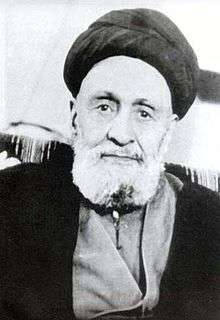Abol-Ghasem Kashani
| Abol-Ghasem Kashani | |
|---|---|
 | |
| Chairman of the Parliament of Iran | |
|
In office 7 August 1952 – 12 March 1953 | |
| Monarch | Mohammad-Reza Pahlavi |
| Prime Minister | Mohammad Mosaddegh |
| Preceded by | Mohammad-Reza Hekmat |
| Succeeded by | Hassan Emami |
| Personal details | |
| Born |
1882 Tehran, Iran |
| Died |
March 14, 1962 (aged 80) Tehran, Iran |
| Nationality | Iranian |
| Political party | Society of Muslim Warriors |
| Other political affiliations | National Front (1949–52) |
| Religion | Shia Islam |
Ayatollah Seyyed Abol-Ghasem Mostafavi Kashani (Persian: آیتالله سید ابوالقاسم مصطفوی کاشانی) (1882 in Tehran, Iran – 14 March 1962 in Tehran) was a prominent Twelver Shia Muslim cleric and former Chairman of the Parliament of Iran.
Early life
His father, Ayatollah Hajj Seyyed Mostafavi Kashani (Persian: آیتالله حاج سید مصطفوی کاشانی), was a noted clergyman of Shiism in his time. Abol-Ghasem was trained in Shia Islam by his religious parents and began study of the Quran soon after learning to read and write.
At 16, Abol-Ghasem went to an Islamic seminary to study literature, Arabic language, logic, semantics and speech, as well as the principles of Islamic jurisprudence, or Fiqh. He continued his education at the seminary in an-Najaf in the Qur'an and Hadiths as interpreted in Shia law, receiving his jurisprudence degree when he was 25.
Later life
Personal life
His son Mostafa died in an accident in 1955; the new prime minister, Hossein Ala', escaped an assassination attempt at the funeral.[1] According to British intelligence, around this time two of his sons were involved in a lucrative business buying and selling import-export licenses for restricted goods.[2]
One of Kashani's children, Mahmoud Kashani, went on to become head of the Iranian delegation to the International Court of Justice in The Hague, Netherlands, in Iran's case with the United States and a presidential candidate in the Iranian presidential elections of 1988 and 2005. His second son is Ahmad Kashani, a former member of Iranian parliament.
Kashani is also the great grandfather of Iranian-American filmmaker Sam Ali Kashani.
Political life
Abol-Ghasem expressed Anti-capitalist leanings from early on in his career and opposed what he saw as "oppression, despotism and colonization." Because of these beliefs, he was especially popular with the poor in Tehran.[3] He also advocated the return of Islamic government to Iran, though this was most likely for political reasons.[4]
Due to nationalist positions, Ayatollah Kashani was arrested and exiled by the British and Soviets. He continued to oppose foreign, especially British, control of Iran's oil industry while in exile. After he returned from exile on 10 June 1950, he continued to protest. Angered by the fact that the Anglo-Iranian Oil Company paid Iran much less than it did the British, he organized a movement against it and was the "virtually alone among the leading mujtahids in joining" nationalist Prime Minister Mohammed Mosaddeq, in his campaign to nationalize the Iranian oil industry in 1951.[5] [6]
Kashani served as speaker of the Majles (or lower house of Parliament), during the oil nationalization, but later turned against Mosaddeq during the 1953 Iranian coup d'état. Kashani protected the violent Islamist group Fada'iyan-e Islam, led by Navvab Safavi, after their expulsion from the Qom seminary by Ayatollah Hosein Borujerdi in 1950. The group then engaged in public assassinations in Tehran in the early 1950s.[7]
References
- ↑ Abbas Milani (2008), Eminent Persians: The Men and Women Who Made Modern Iran, 1941-1979, Volumes One and Two, Volume 1, Syracuse University Press, p348
- ↑ Ervand Abrahamian (1993), Khomeinism: Essays on the Islamic Republic, I.B.Tauris, p108
- ↑ Dabby, Elias. "The Ayatollah and Me." The Scribe - Journal of Babylonian Jewry. Issue 70, October 1998.
- ↑ Samii, A.W. "Falsafi, Kashani and the Baha'is
- ↑ MacKay, Sandra, The Iranians, (Plume, 1998) p.198
- ↑ Abrahamian, Ervand, Khomeinism : essays on the Islamic Republic, University of California Press, c1993. p.107
- ↑ James Buchan. Days of God: The Revolution in Iran and its Consequences. p 65–6. Simon & Schuster. 2012.